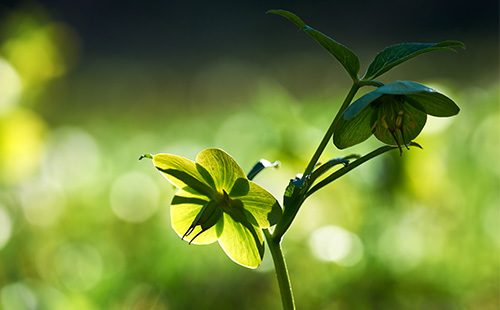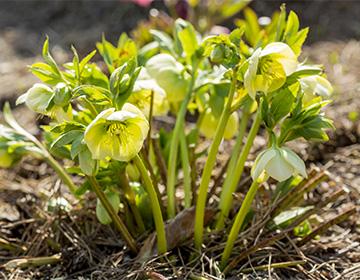The content of the article
Caucasian hellebore is an evergreen herbaceous perennial. Blooms in early spring, sometimes even with frost. It is appreciated by gardeners for aesthetic qualities and early flowering. In folk medicine, species are often confused - they use a reddish or oriental one. In the case of the first, poisoning often occurs, since it is more toxic. And the eastern one lacks medicinal qualities due to the content of useful substances in small quantities.
Botanical characteristic
The plant is unpretentious to the quality of the soil. It can grow on humus-rich soil on the edges of deciduous and coniferous-deciduous forests, located on stony territories in gorges and on mountain slopes. It develops well at an altitude of about 1000 m above sea level. In rare cases, forms thickets. Shade-tolerant, however, requires moisture. Often thickets form along the banks of mountain rivers and streams.
On the territory of Russia grows in the Caucasus Mountains, in the Krasnodar Territory, on the Black Sea coast, in the Kuban foothills. Widely distributed in Georgia, rarely found in the Carpathians. To know the plant in the wild will help morphological characteristics.
- Underground part. It is represented by a shortened rhizome located horizontally. Short cordate roots extend from it. The entire underground part is covered with brown bark.
- The stalks. They are peduncles. The top may branch. In this case, two flowers form on the plant. Mostly bare, occasionally there are stems with a pair of sessile leaves. The shape is cylindrical. Large specimens reach a height of half a meter.
- Leaves. Petiole leaves grow directly from the rhizome, forming a basal rosette. A palmately dissected leaf plate - there are 9-11 pointed lanceolate lobes.
- Flowers. They have a regular shape, double perianth, diameter reaches 4 cm. Color - pale yellow-green. Brownish streaks are present at the base of the petals. It blooms in February and March (depending on the region).
- Fruit. Non-grown leaflets inside contain a large number of smooth black seeds.
Hellebore propagates vegetatively, as well as seeds. To plant flower beds, seeds are first germinated at room conditions.
Harvesting raw materials
This drug is not distributed through pharmacies, and its collection in the wild is prohibited. There are two ways out: to grow a culture in our own garden plot or to purchase from herbalists. Properly prepared raw materials are used for two to three years.
- Collection. They start harvesting in the fall, after shedding seeds. Adult individuals dig a shovel, shake the roots from the ground.
- Training. Rhizomes along with cord-shaped roots are washed with a large amount of cold running water. To get rid of excess moisture, hang them under a canopy on a thick rope for a couple of days.
- Drying. Hardened rhizomes are dried on a pallet in the shade with through ventilation. When using dryers adhere to temperatures up to 45ºС.
Dried roots exude an unpleasant suffocating odor. Their surface is brown, matte, and the fracture is beige. It tastes hot and bitter. Store separately from other medicinal raw materials in plastic bags in a dark and dry place.
Composition
The effect of hellebore on the human body has not been thoroughly studied. Scientists managed to establish only the basic compounds in the chemical composition of the grass. It is believed that it is undiscovered substances that have a comprehensive beneficial effect. However, even a known part of the wintering team is impressive.
- Cardiac glycosides. The main one is Korelborin K. This is a unique compound superior in strength to the lily of the valley glycosides. It remains active even after interacting with gastric juice, which distinguishes it from other compounds of the same kind. Hellebore glycosides accumulate in the body, are defined as medium toxic. They stimulate the work of the heart, strengthen heart contractions, slowing down the rhythm, normalize blood circulation and oxygen saturation of tissues.
- Steroid Saponins. These substances stimulate the immune system, regulate the functioning of the ciliary epithelium of the bronchi, providing an expectorant effect, have anti-inflammatory properties, and improve the functioning of the glands.
- Fatty acid. They have antioxidant properties, are necessary for the regulation of immunity and the construction of cell membranes, as well as for the synthesis of enzymes.
- Alkaloids. Small doses provide a sedative effect, while high doses provide a tonic effect. They exhibit antispasmodic and analgesic effects. Slightly lower blood pressure.
- Antraglycosides. They exhibit laxative, choleretic and diuretic effects due to irritating properties. Provide a comprehensive cleansing of the body.
- Flavonoids. They have vasoprotective and capillary-stabilizing properties, enhance the formation of bile, exhibit antioxidant activity and increase the similar properties of vitamins A, E and C.
- Coumarins. They have a cytostatic effect. Toxic to tumor cells. They have an immunostimulating effect and the ability to regulate blood viscosity.
- Vitamins Impressive concentrations of vitamins A, C, E, D were revealed. They regulate metabolism, participate in the production of hormones and in the process of tissue regeneration.
Healing properties
This plant has become famous at the same time and a huge list of indications for use, and its health hazard. The peak in the popularity of grass falls on the 90s. Then she treated all kinds of diseases. However, a wave of poisonings tempered the ardor of those who want to rejuvenate, improve their health and lose weight. Herbalists explain the negative consequences of using herbal remedies by the fact that patients in an attempt to accelerate the effect deliberately exceeded the dose. Today in folk medicine, culture is used in the following cases.
- With heart disease. Used for the treatment of tachycardia, heart failure, as well as for the prevention of various heart ailments. Cardiotonic and cardioprotective actions are provided by glycosides.
- For weight loss. The tool pacifies appetite, accelerates saturation, cleanses the intestines and stimulates metabolic processes. Grass burns subcutaneous and internal fat deposits. After taking it, no stretch marks remain, the skin is rejuvenated, cellulite disappears.
- To normalize the composition of the blood. It is common for hellebore to lower blood sugar, stimulate the pancreas to produce insulin (which is important for diabetes), reduce cholesterol and prevent atherosclerosis. In addition, the plant is prescribed for the treatment of this disease.
- To cleanse the body. Culture cleanses the blood, lymphatic system, gall bladder, kidneys, liver, intestines. It removes toxins, and also destroys damaged and worn cells, triggering tissue repair. It promotes rejuvenation. It also establishes a mineral metabolism - removes excess salts, reducing the manifestations of gout and osteochondrosis.
- For the prevention of disease. Grass strengthens the immune system. It does not change the picture of blood, but establishes the production, maturation and differentiation of protective immune cells.
- To optimize the functions of the digestive tract. Herbal remedies improve the digestive tract - stimulate the secretory cells, promote the saturation of juices with enzymes, inhibit the growth of tumors in the abdominal organs, eliminate ulcers and inflammatory processes. The plant is used for hepatitis of viral and inflammatory etiology, as well as for the purification of bile.
- With diseases of the genitourinary sphere. These include bacterial diseases of the kidneys and urinary tract, deposition of urinary calculi, impaired reproductive organs, genital insufficiency, pathological neoplasms in the structure of organs. Also in the list of indications - infertility, malfunctioning of the thyroid gland.
- To normalize the central nervous system. The mild sedative effect of the herb is surprisingly combined with a tonic. When taking hellebore, an increase in mental and physical working capacity, stress resistance, improvement of mood, normalization of mental processes are noted. At the same time, nervousness and anxiety go away, night sleep is optimized. The plant treats psychosis and epilepsy.
- With neoplasms. The tool is used for female pathologies (fibroids, cervical cancer, ovarian cysts), benign and malignant tumors in the digestive tract, with prostate adenoma, skin cancer. The plant not only slows the progression of oncology, but also prevents the appearance of metastases.

Prescription Drugs
The most famous medicine based on hellebore is a powder made from its roots. This tool is used to treat chronic diseases and weight loss. Drink, starting with a dose of 50 mg (at the tip of a knife). An additional 50 mg is added every 11 days until the dosage reaches 300 mg. If, after increasing the dose, the state of health worsens or side effects are manifested, then they return one or two back and leave everything like this until the end of the course. Its duration is six months. If necessary, after a two-month break, you can repeat.
The drug is also taken episodically as a laxative - 50 mg in a mixture with honey.
Decoction
Features Drink to eliminate cough, pleurisy therapy, tuberculosis. Rubbed externally with osteochondrosis, rheumatism and gout.
Preparation and use
- Half a teaspoon of powder is poured into 0.5 liters of boiling water. Put a container in a water bath.
- After boiling, heat in the bath for half an hour.
- Ten minutes, insist the remedy, after which it is filtered.
- Take inside a teaspoon up to four times a day. Twice a day, used externally for joint pain.
Tincture
Features Alcohol tincture replaces powder. The tool is easier to take, it is allowed to add it to tea.
Preparation and use
- In a glass container mix 50 g of the roots of the plant and 0.5 l of diluted in half alcohol or quality vodka.
- They put in a dark place for a week.
- Take the drug in half a teaspoon in the morning on an empty stomach. When the remedy ends, the residues are diluted with 0.5 l of vodka and continue to drink as before.
The drug is prohibited for use in pregnant, lactating, children. You can not eat grass with endocarditis, coronary heart disease, tachycardia, gallstone disease. Neglect of contraindications leads to the manifestation of side effects: nausea, vomiting, delirium, hyperthermia, intestinal inflammation. Severe intoxication is fraught with the death of the patient. The reaction to the plant may be different, depending on the individual characteristics of the body. Some people are cured of chronic pathologies, while others do not feel any effect.

